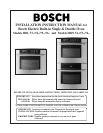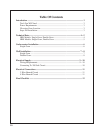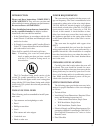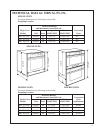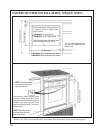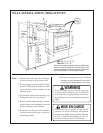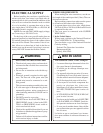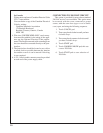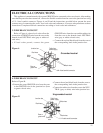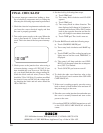
9
ELECTRICAL SUPPLY
Before installing the oven have a qualified elec-
trician verify that your home is provided with ad-
equate electrical service and that the addition of the
oven will not overload the branch circuit on which
it is to be installed. A separate three-wire or four-
wire single phase, 240 Volt, 60 Hz, or a 208 Volt, 60
Hz branch circuit is required.
NOTE: For use with 208 V, 60 Hz supply voltage,
see Connecting to 208 Volt Circuit.
For hook-up of the oven you will need to have an
approved junction box installed where it will be eas-
ily reached through the front of the cabinet where
the oven will be located. The oven has 3 feet of con-
duit. Allow two to three feet of slack in the line so
that the oven can be moved if servicing is ever nec-
essary. DO NOT shorten the flexible conduit.
WIRING REQUIREMENTS
When making the wire connections, use the en-
tire length of the conduit provided (3 feet). The con-
duit must not be cut.
Before making connections make sure the power
is off and read and observe the following:
1. A separate three-wire or four wire, single phase,
240 Volt, 60 Hz or 208 Volt, 60 Hz branch circuit
is required for the oven.
2. The oven must be connected with COPPER
WIRE ONLY.
3. In the United States:
Wiring must conform to the National Electrical
Code, ANSI/NFPA No. 70 latest edition.
You can obtain a copy of the National Electrical
Code by writing:
National Fire Protection Association
Batterymarch Park
Quincy, MA 02269
WARNING
ELECTRICAL SHOCK HAZARD
• The electrical power to the oven branch cir-
cuit must be shut off while line connections
are being made.
• Do not use an extension cord with this ap-
pliance.
• Electrical ground is required on this appli-
ance. The free end of the green wire (the
ground wire) must be connected to a suit-
able ground.
This wire must remain grounded to the oven.
• If cold water pipe is interrupted by plastic,
nonmetallic gaskets, union connections or
other insulating materials, DO NOT use for
grounding.
• DO NOT ground to a gas pipe.
• DO NOT have a fuse in the NEUTRAL or
GROUNDING circuit. A fuse in the NEU-
TRAL or GROUNDING circuit could re-
sult in an electrical shock.
• Check with a qualified electrician if you are
in doubt as to whether the appliance is prop-
erly grounded.
Failure to follow these instructions could re-
sult in serious injury or death.
MISE EN GARDE
DANGER DE CHOC ELECTRIQUE
• Le courant électrique alimentant le four doit
être coupé durant le branchement.
• N’utilisez pas de rallonge électrique avec
cet appareil.
• Cet appareil nécessite une mise à la terre.
L’extrémité du fil vert (fil de mise à la terre)
doit être reliée à une mise à la terre adéquate.
Ce fil électrique doit rester relié au four.
• Si les tuyaux d’eau froide comportent des
parties en plastique, des joints non-
métalliques ou d’autres matériaux isolants,
NE LES UTILISEZ PAS pour la mise a la
terre.
• N’UTILISEZ PAS DE TUYAUX DE GAZ
pour la mise à la terre.
• Ne placez pas de fusible sur le fil NEUTRE
ou le fil de MISE A LA TERRE. Un tel fus-
ible pourrait resulter en un choc électrique.
• Si vous avez le moindre doute, faites vérifier
par un électricien que votre appareil est bien
mis à la terre.
Le fait de ne pas se conformer à ces instruc-
tions peut entraîner de sérieuses blessures ou
la mort.



